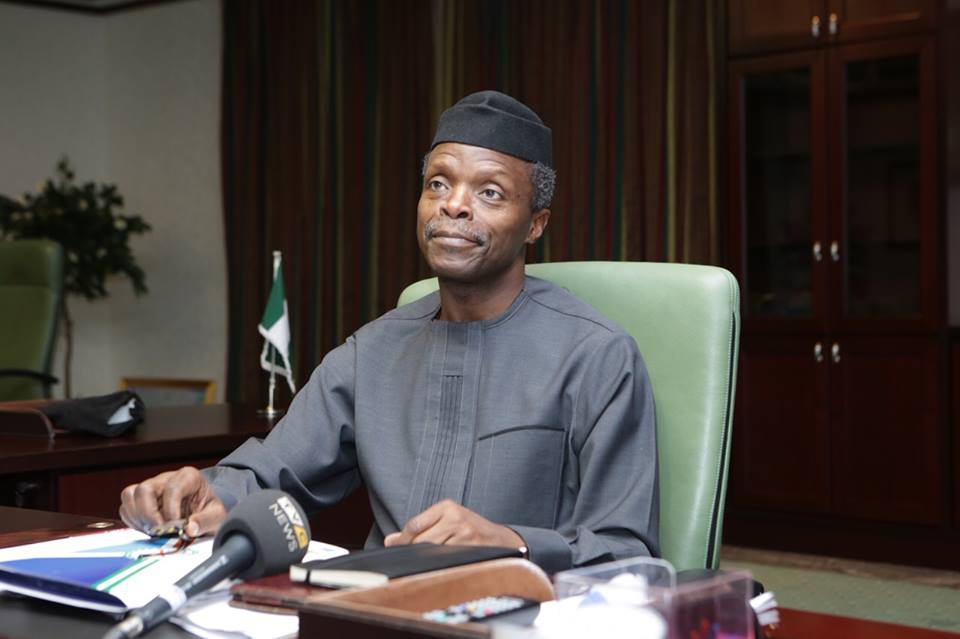Vice President, Yemi Osinbajo has said there was no alternative to a robust intra-African trade in the quest to grow the continent on a sustainable basis.
Osinbajo, who spoke at the High-Level Policy Private Sector Trade and Investment Facilitation Partnership Forum in Abuja, Wednesday, said there has been a steady Direct Foreign Investments, DFI, into the region with the 2016 figure standing at $56.2 billion and prospects of rising to $57.5 at the end of this year.
He, however, said that though the world was demonstrating a growing interest in Africa, not much would be achieved unless trade among countries of the region grew significantly in the years ahead.
The Vive President said: “Two days ago the world bank announced that Africa’s largest economy has moved up 24 places in the world bank ease of doing business ranking and we have been declared one of the top reforming economies in the world.
“The World Bank in its Doing Business 2018 report shows that 34 out of the 48 countries in sub- Sahara Africa has at least one business regulatory reform in the previous years, so Africa is the second fastest destination today for foreign direct investors in 2016 foreign direct investment to Africa was $56.2b and is expected to rise from $57.5b this year.
“It is certain that today, the rest of the world see an Africa that is ready for business and a place to be in future years. And so what is most needed is to deepen trade and investment more boldly.
Japan lunched a $30b initiative for Africa, recently China has also lunched a $60b initiative, South Korea lunched $10b and India $10b initiative.
“It is clear that the world is getting set for African Century, but that glorious economic future is underpinned by trade and investment. As you can see from the Economic trauma cause by so call resource curses in many of our nations, there is no other pathway for sustainable job creation and growth but trade and investment.
“This is true for our dear nation, as it true for our entire region. Without prejudice to the strategic value and necessity of multilateralism, never before has regionalism be as important as it today.
”It is the starting point for market enlargement and the locus for all our efforts to integrate the market structures an establish supply chains. We must move from rhetoric to actions in developing our regional infrastructure and regional value chains.
Indeed we must see regionalism and multilateralism as being complementary. The former is an important stepping stone to the later.
“They are vehicles for enhancing development and mostly work in such a way that they serve the good of our nations and our people.”
He urged caution and action for African nations to benefit from the Trade facilitation Agreement of the World Trade Organisation (WTO) which has come into effect.
Osinbajo added that the proposed Continental Free Trade Area (CFTA) had no alternative and must succeed for the continent to survive.
“Nigerian’s commitment to fostering regional integration through ECOWAS remains very strong indeed. Even as we lead the on-going negotiations to conclude by the end of this year, the Continental Free Trade Area (CFTA) along the CFTA has no plan B for us; we absolutely must succeed.
“On the World Trade Organisation’s Trade facilitation Agreement which has come into effect, Prof. Osinbajo said the benefits would not be automatic for developing economies.
“According to WTO’s computable general equilibrium simulations presented in the world trade report 2015, export gains from the TFA would be 750billion and 1trillion dollars per annum.
“Developing countries in particular would see their export increase by 36% much more than for other categories of WTO members. And the WTO also predicts that the TFA if fully implemented, access to foreign markets will increase by 39% for developing countries and 60% for LDC’s, with potential gains of up to 50 trillion dollars per annum for African export.
“But it will serve us well to pay some attention to the challenges that we would confront in accessing the gains of the facilitation agreement. The significant regulatory, legislative and infrastructure changes that needs to be made in accordance to the commitment that have been made, come with a cost; regulatory cost, infrastructural cost and training cost which may be considerable.”

